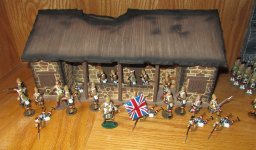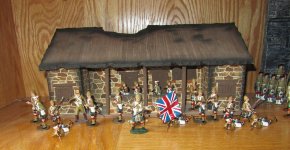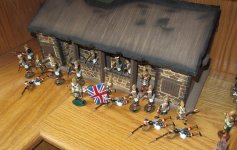I recently was able to purchase the Zulu War Farmhouse along with a bunch of Zulu warriors and a handful of Highlanders (Red dress uniforms). I have a bunch of extra Highlanders in active service uniforms. Actually, I don't get the whole Red/Khaki uniform thing with the Highlanders. I believe one is dress (Red) & active (Khaki), unless they are 24th Foot Reg.. I probably need a history lesson! The Zulu Farmhouse is stunning, considering the time of production. I did not use any of the Zulu warriors in the display. Anyhow, here are a few pictures.
View attachment 108661
View attachment 108662
View attachment 108663
Great find Peter. Here is a little quote from the text of the book on the subject:
By 1987/1988 . . . to complement the first release of Zulus, at the suggestion of Ron Leh of Sommerset, then an early King & Country dealer, the dismounted Seaforth Officer with dead horse (DMO1) was also released as both 24th Foot (DM02) and 8th Foot (DM03) Officers. . . .
The casting for the dismounted Seaforth Officer with dead horse (DMO1) was also released as both 24th Foot (DM02) and 8th Foot (DM03) Officers. These officers wore red tunics with green (24th foot) or blue (8th foot) facings, navy blue pants with red stripes on the seams, brown knee boots, and had the Roman numerals for 24 (“XXIV”) or 8 (“VIII”) on the canteens on the rear of their right hips. These figures also retailed for $39. . . .
As a point of interest, depicted on the back of K&C's early flyers, along with the set descriptions and prices, are reproductions of black and white 19th Century prints of British troops in action on the various battlefields of “Queen Victoria’s Little Wars”. On the back of the winter 1984/1985 flyer is a drawing of a field officer, wounded in the forehead and left arm, firing a revolver over his dead horse. This exact figure was later produced by King & Country as sets (DMO1 (Seaforth), DM02 (24th Foot), DMO3 (8th Foot) and an unidentified dismounted officer dressed completely in Khaki (presumably DM04, and believed by the author to depict one of the 1898 era lancers depicted in the winter 1984/1985 catalogue).
The original, primitively sculpted, Zulus originally came in three poses, sold in a six figure set (ZULU1), but within a year Andy replaced one of the first three poses with a fourth pose, and the Zulus were now sold in two sets: ZULU1 and ZULU2. Shortly thereafter a limited number of dead Zulus were also produced and sold.
The three originally available poses were advancing (described as running) with shields and rifles (held upright, not pointing), advancing with shields and assegais (stabbing spears, properly called “ikluwa” by the Zulus), held at shoulder height, and advancing with shields and clubs (knobkerries). These three figures each were attired in white head-dresses, white fur loin clothes and calf-coverings, with leopard skin “tank tops”, and shields in tan with reddish-brown spots. The set of six (two of each of these poses) sold for $59.
The fourth pose, which replaced the first, was a Zulu crawling with shield and rifle. By the release date of the fourth figure, the shields of all four figures were painted white with black spots, and the fur “tank tops” were now white, and loin clothes were white and black on the advancing figures, and tiger skin on the crawling figures. The two Zulu sets now available consisted of the following: ZULU1: 2 Zulus advancing with spears and shields, 2 Zulus advancing with clubs and shields, and 2 crawling with rifles and shields ($59); ZULU2: 4 Zulus advancing with spears and shields, 4 Zulus advancing with clubs and shields, and 2 crawling with rifles and shields ($89). The dead Zulu, lying facedown with a spear in one hand, and a separate black and white shield, retailed for $12. . . .
New Zulus were released in 1994, and in 1995 a Zulu War burning farmhouse (Roarkes Drift) was produced. . . .
The new Zulus were released in 9 poses (Zulu A through Zulu I) with two poses added in 1996 (Zulu J and Zulu K). In Andy’s own words “[t]he sculpting and painting of these figures is, quite simply, the finest on the market and King & Country’s best.” False modesty aside, these figures were extraordinarily well painted for glossy figures, although the sculpting was nothing to write home about. The Zulus were painted either as dark skinned Africans (dark brown skin) or lighter skinned Africans (reddish brown skin). According to Andy, this resulted merely from experimentation with the paints.
The figures included four standing Zulu officers, two holding up shields in their right hands and spears in their left hands at hip level [Zulu F and G], two holding up rifles in their right hands and knobkerries in their left hands at hip level [Zulu H and I] (all with merely different arms or weapons on the same sculpting), distinguishable by the skins they wear (one of each figure wearing leopard [F and H], one with shield wearing Lion [G], one with Rifle wearing Zebra
). Another single casting of a Zulu advancing with a shield on his left arm is made into three figures by right arms carrying a spear [C], a rifle [D] or a knobkerrie [E]. One stands clumsily firing a rifle [A] while another stands wearing a torn 24th or 8th foot red coat, holding a captured rifle at waist level . The first of the two later figures kneels next to a rifle box grabbing a rifle with his right hand, holding a spear in his left hand by his left side [J] while the other lies prone loading a captured Martini-Henry rifle [K]. . . .
In 1995, a Zulu War burning farmhouse (Roarkes Drift) was produced. This wood building was well constructed with real wood detail pieces such as shutters and a window ledge. The roof was also constructed of wood, cut away and painted to appear as a burning thatch roof. The walls of the building were covered with plaster on which individual stones were etched and painted. This building, designated ZWF1, retailed for $128.







